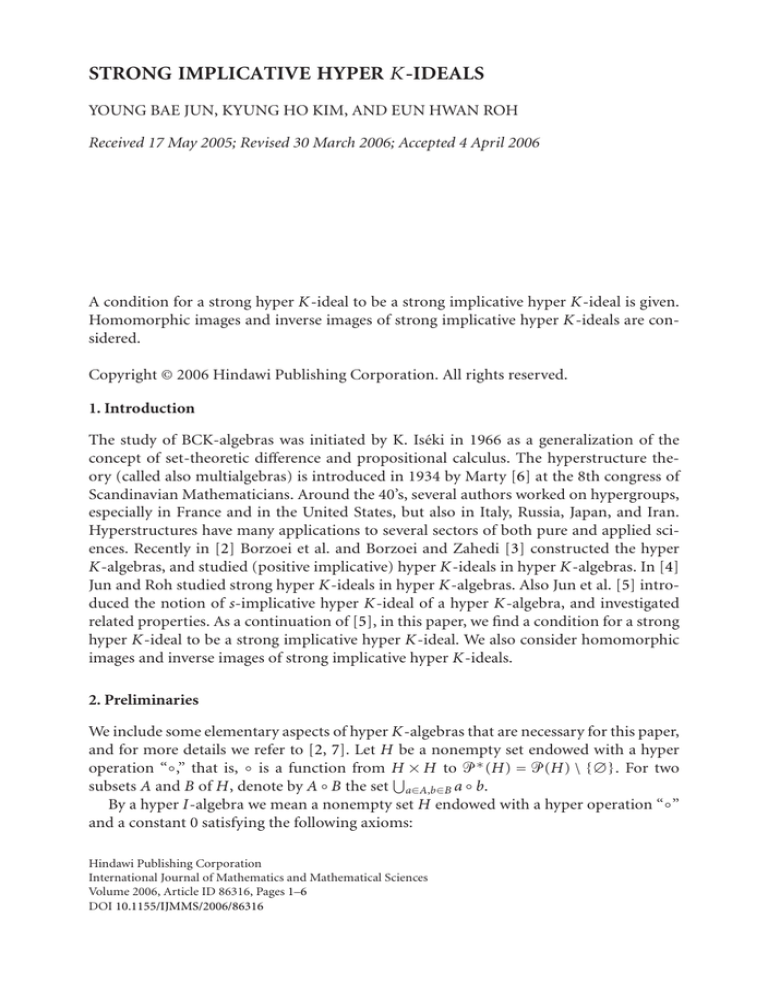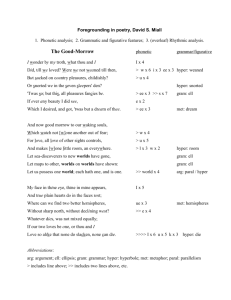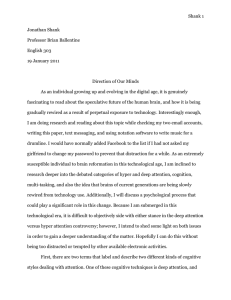
STRONG IMPLICATIVE HYPER K-IDEALS
YOUNG BAE JUN, KYUNG HO KIM, AND EUN HWAN ROH
Received 17 May 2005; Revised 30 March 2006; Accepted 4 April 2006
A condition for a strong hyper K-ideal to be a strong implicative hyper K-ideal is given.
Homomorphic images and inverse images of strong implicative hyper K-ideals are considered.
Copyright © 2006 Hindawi Publishing Corporation. All rights reserved.
1. Introduction
The study of BCK-algebras was initiated by K. Iséki in 1966 as a generalization of the
concept of set-theoretic difference and propositional calculus. The hyperstructure theory (called also multialgebras) is introduced in 1934 by Marty [6] at the 8th congress of
Scandinavian Mathematicians. Around the 40’s, several authors worked on hypergroups,
especially in France and in the United States, but also in Italy, Russia, Japan, and Iran.
Hyperstructures have many applications to several sectors of both pure and applied sciences. Recently in [2] Borzoei et al. and Borzoei and Zahedi [3] constructed the hyper
K-algebras, and studied (positive implicative) hyper K-ideals in hyper K-algebras. In [4]
Jun and Roh studied strong hyper K-ideals in hyper K-algebras. Also Jun et al. [5] introduced the notion of s-implicative hyper K-ideal of a hyper K-algebra, and investigated
related properties. As a continuation of [5], in this paper, we find a condition for a strong
hyper K-ideal to be a strong implicative hyper K-ideal. We also consider homomorphic
images and inverse images of strong implicative hyper K-ideals.
2. Preliminaries
We include some elementary aspects of hyper K-algebras that are necessary for this paper,
and for more details we refer to [2, 7]. Let H be a nonempty set endowed with a hyper
× H to ᏼ∗ (H) = ᏼ(H) \ {∅}. For two
operation “◦,” that is, ◦ is a function from H
subsets A and B of H, denote by A ◦ B the set a∈A,b∈B a ◦ b.
By a hyper I-algebra we mean a nonempty set H endowed with a hyper operation “◦”
and a constant 0 satisfying the following axioms:
Hindawi Publishing Corporation
International Journal of Mathematics and Mathematical Sciences
Volume 2006, Article ID 86316, Pages 1–6
DOI 10.1155/IJMMS/2006/86316
2
Strong implicative hyper K-ideals
(H1) (x ◦ z) ◦ (y ◦ z) < x ◦ y,
(H2) (x ◦ y) ◦ z = (x ◦ z) ◦ y,
(H3) x < x,
(H4) x < y and y < x imply x = y,
for all x, y,z ∈ H, where x < y is defined by 0 ∈ x ◦ y and for every A,B ⊆ H, A < B is
defined by ∃a ∈ A and ∃b ∈ B such that a < b. If a hyper I-algebra (H, ◦,0) satisfies an
additional condition:
(H5) 0 < x for all x ∈ H,
then (H, ◦,0) is called a hyper K-algebra (see [2]).
In a hyper I-algebra H, the following hold (see [2, Proposition 3.4]):
(a1) (A ◦ B) ◦ C = (A ◦ C) ◦ B,
(a2) x ◦ (x ◦ y) < y,
(a3) x ◦ y < z ⇔ x ◦ z < y,
(a4) A ◦ B < C ⇔ A ◦ C < B,
(a5) (x ◦ z) ◦ (x ◦ y) < y ◦ z,
(a6) (A ◦ C) ◦ (B ◦ C) < A ◦ B,
(a7) A ◦ (A ◦ B) < B,
(a8) A < A,
(a9) A ⊆ B implies A < B,
for all x, y,z ∈ H and for all nonempty subsets A, B, and C of H.
A nonempty subset I of a hyper K-algebra H is called a weak hyper K-ideal of H (see
[2]) if it satisfies
(I1) 0 ∈ I,
(I2) (for all x, y ∈ H) (x ◦ y ⊆ I, y ∈ I ⇒ x ∈ I).
A nonempty subset I of a hyper K-algebra H is called a hyper K-ideal of H (see [2]) if
it satisfies (I1) and
(∀x, y ∈ H) (x ◦ y < I, y ∈ I =⇒ x ∈ I).
(2.1)
Note that every hyper K-ideal is a weak hyper K-ideal (see [1]). A nonempty subset I
of a hyper K-algebra H is called a strong hyper K-ideal of H (see [4]) if it satisfies (I1) and
(∀x, y ∈ H)
(x ◦ y) ∩ I = ∅, y ∈ I =⇒ x ∈ I .
(2.2)
Note that every strong hyper K-ideal is a hyper K-ideal (see [4]).
A nonempty subset I of a hyper K-algebra H is called a weak implicative hyper K-ideal
of H (see [1]) if it satisfies (I1) and
(∀x, y,z ∈ H)
(x ◦ z) ◦ (y ◦ x) ⊆ I, z ∈ I =⇒ x ∈ I .
(2.3)
A nonempty subset I of a hyper K-algebra H is called an implicative hyper K-ideal of
H (see [1]) if it satisfies (I1) and
(∀x, y,z ∈ H)
(x ◦ z) ◦ (y ◦ x) < I, z ∈ I =⇒ x ∈ I .
(2.4)
Note that every implicative hyper K-ideal is a weak implicative hyper K-ideal (see [1]).
Young Bae Jun et al. 3
Table 3.1
◦
0
a
b
c
0
a
b
c
{0}
{0}
{0}
{0}
{a}
{0}
{0}
{0}
{b}
{b}
{0}
{b}
{c}
{a,b}
{0,a}
{0,b}
3. Strong implicative hyper K-ideals
In what follows let H denote a hyper K-algebra unless otherwise specified. In [5], Jun
et al. introduced the notion of s-implicative hyper K-ideal of H as follows.
Defintion 3.1 [5]. A nonempty subset I of H is called an s-implicative hyper K-ideal of H
if it satisfies (I1) and
(∀x, y,z ∈ H)
(x ◦ z) ◦ (y ◦ x) ∩ I = ∅, z ∈ I =⇒ x ∈ I .
(3.1)
In this paper it is called a strong implicative hyper K-ideal of H.
Example 3.2. Let H = {0,a,b,c} be a hyper K-algebra with the Cayley table (Table 3.1).
Then I := {0,a,c} is a strong implicative hyper K-ideal of H. But I := {0,a} is not a strong
implicative hyper K-ideal of H since ((c ◦ a) ◦ (0 ◦ c)) ∩ I = {a} and a ∈ I but c ∈ I.
Theorem
3.3. If {Iλ |λ ∈ Λ} is a family of strong implicative hyper K-ideals of H, then
λ∈Λ Iλ is a strong implicative hyper K-ideal of H.
Proof. Clearly
0 ∈ λ∈Λ Iλ . Let x, y,z ∈ H be such that ((x ◦ z) ◦ (y ◦ x)) ∩ ( λ∈Λ Iλ ) = ∅
and z ∈ λ∈Λ Iλ . Then ((x ◦ z) ◦ (y ◦ x)) ∩ Iλ= ∅ and z ∈ I
λ for all λ ∈ Λ. By using (3.1),
we have x ∈ Iλ for all λ ∈ Λ, and hence x ∈ λ∈Λ Iλ . Hence λ∈Λ Iλ is a strong implicative
hyper K-ideal of H.
Lemma 3.4 [5]. Every strong implicative hyper K-ideal of H is a strong hyper K-ideal.
Proposition 3.5. Let I be a strong hyper K-ideal of H, and A,B ⊆ H. If (A ◦ B) ∩ I = ∅
and B ⊆ I, then A < I.
Proof. Since A ◦ B = a∈A,b∈B a ◦ b and (A ◦ B) ∩ I = ∅, there exists t ∈ a ◦ b for some
a ∈ A, b ∈ B such that t ∈ I. Hence (a ◦ b) ∩ I = ∅. Since I is a strong hyper K-ideal and
b ∈ B ⊆ I, we have a ∈ I. Therefore we get A < I.
Now we give a condition for a strong hyper K-ideal to be a strong implicative hyper
K-ideal.
Theorem 3.6. Let I be a strong hyper K-ideal of H such that
(∀x, y ∈ H)
x ◦ (y ◦ x) < I =⇒ x ∈ I .
Then I is a strong implicative hyper K-ideal of H.
(3.2)
4
Strong implicative hyper K-ideals
Table 3.2
◦
0
a
b
0
a
b
{0}
{0}
{0}
{a}
{0,a}
{a}
{a,b}
{0,a}
{0,a}
Proof. Let x, y,z ∈ H be such that ((x ◦ z) ◦ (y ◦ x)) ∩ I = ∅ and z ∈ I. Then we have
((x ◦ (y ◦ x)) ◦ z) ∩ I = ∅. It follows from Proposition 3.5 that x ◦ (y ◦ x) < I so from
(3.2) that x ∈ I. Therefore I is a strong implicative hyper K-ideal of H.
Theorem 3.7. Every strong implicative hyper K-ideal I of H satisfies (3.2).
Proof. Let I be a strong implicative hyper K-ideal of H and let x, y ∈ H be such that
x ◦ (y ◦ x) < I. The inclusion x ◦ (y ◦ x) ⊆ (x ◦ 0) ◦ (y ◦ x) implies that (x ◦ 0) ◦ (y ◦ x) < I.
Hence x ∈ I since 0 ∈ I.
Corollary 3.8. Let I be a nonempty subset of H. Then I is a strong implicative hyper
K-ideal of H if and only if I is a strong hyper K-ideal of H that satisfies the condition (3.2).
Theorem 3.9. Every strong implicative hyper K-ideal is a weak implicative hyper K-ideal.
Proof. Straightforward.
In general, a weak implicative hyper K-ideal may not be a strong implicative hyper
K-ideal as seen in the following example.
Example 3.10. Let H = {0,a,b} be a hyper K-algebra with the Cayley table (Table 3.2).
Then I := {0,b} is a weak implicative hyper K-ideal of H, but I is not a strong implicative
hyper K-ideal since ((a ◦ 0) ◦ (a ◦ a)) ∩ I = ∅ and 0 ∈ I but a ∈ I.
Our future work will focus on finding conditions for a weak implicative hyper K-ideal
to be a strong implicative hyper K-ideal.
4. Homomorphisms of hyper K-algebras
Defintion 4.1 [7]. Let H1 and H2 be two hyper K-algebras. A mapping f : H1 → H2 is said
to be a homomorphism if it satisfies
(i) f (0) = 0,
(ii) (for all x, y ∈ H1 ) ( f (x ◦ y) = f (x) ◦ f (y)).
Moreover if f is 1 − 1 (or onto), we say that f is a monomorphism (or epimorphism).
And if f is both 1 − 1 and onto, we say that f is an isomorphism.
Proposition 4.2. Let f : H1 → H2 be a homomorphism of hyper K-algebras. Then
∀A,B ⊆ H1
A < B =⇒ f (A) < f (B) .
(4.1)
Proof. Let A,B ⊆ H1 be such that A < B. Then ∃a ∈ A, ∃b ∈ B such that a < b, that is,
0 ∈ a ◦ b. Hence 0 = f (0) ∈ f (a ◦ b) = f (a) ◦ f (b), which implies f (A) < f (B).
Young Bae Jun et al. 5
Theorem 4.3. Let f : H1 → H2 be a homomorphism of hyper K-algebras. If I is a strong
hyper K-ideal of H2 , then f −1 (I) is a strong hyper K-ideal of H1 .
Proof. Let I be a strong hyper K-ideal of H2 . Clearly 0 ∈ f −1 (I). Let x, y ∈ H1 be such
that (x ◦ y) ∩ f −1 (I) = ∅ and y ∈ f −1 (I). Then we have
∅ = f (x ◦ y) ∩ f −1 (I) ⊆ f (x ◦ y) ∩ f f −1 (I) ⊆ f (x) ◦ f (y) ∩ I,
(4.2)
and so ( f (x) ◦ f (y)) ∩ I = ∅ and f (y) ∈ f ( f −1 (I)) ⊆ I. Since I is a strong hyper K-ideal
of H2 , we have f (x) ∈ I and so x ∈ f −1 (I). Therefore f −1 (I) is a a strong hyper K-ideal
of H1 .
Theorem 4.4. Let f : H1 → H2 be a homomorphism of hyper K-algebras. If I is a strong
implicative hyper K-ideal of H2 , then f −1 (I) is a strong implicative hyper K-ideal of H1 .
Proof. The proof is similar to the proof of Theorem 4.3 by some modification.
Theorem 4.5. Let f : H1 → H2 be a homomorphism of hyper K-algebras. Then ker f :=
{x ∈ H1 | f (x) = 0} is a strong hyper K-ideal of H1 .
Proof. First we show that {0} is a strong hyper K-ideal of H2 . To do this, let x, y ∈ H1 be
such that (x ◦ y) ∩ {0} = ∅ and y ∈ {0}. Then y = 0 and so 0 ∈ x ◦ 0 since (x ◦ 0) ∩ {0} =
∅. Thus we have x < 0. By (H4) and (H5), we get x = 0 ∈ {0}. This shows that {0} is a
strong hyper K-ideal of H2 . It follows from Theorem 4.3 that ker f = f −1 ({0}) is a strong
hyper K-ideal of H1 .
In general, a strong hyper K-ideal {0} may not be a strong implicative hyper K-ideal.
For example, consider the hyper K-algebra H of Example 3.2. Clearly {0} is a strong
hyper K-ideal of H, while it is not a strong implicative hyper K-ideal of H since ((c ◦ 0) ◦
(b ◦ c)) ∩ {0} = ∅ and 0 ∈ {0} but c ∈ {0}.
Theorem 4.6. Let f : H1 → H2 be a homomorphism of hyper K-algebras. If f is onto and I
is a strong hyper K-ideal of H1 which contains ker f , then f (I) is a strong hyper K-ideal of
H2 .
Proof. Let I be a strong hyper K-ideal of H1 . Clearly 0 ∈ f (I). Let x, y ∈ H2 be such
that (x ◦ y) ∩ f (I) = ∅ and y ∈ f (I). Since y ∈ f (I) and f is onto, there are y1 ∈ I and
x1 ∈ H1 such that y = f (y1 ) and x = f (x1 ). Thus
∅ = (x ◦ y) ∩ f (I) = f (x1 ◦ y1 ) ∩ f (I),
(4.3)
and so there exists a ∈ H2 such that a ∈ f (x1 ◦ y1 ) and a ∈ f (I). It follows that there are
a1 ∈ x1 ◦ y1 and b1 ∈ I such that a = f (a1 ) and a = f (b1 ) so that
0 ∈ a ◦ a = f a1 ◦ f b1 = f a1 ◦ b1 ,
(4.4)
which implies that f (c) = 0 for some c ∈ a1 ◦ b1 . Hence c ∈ ker f ⊆ I and so (a1 ◦ b1 ) ∩
I = ∅. Now since I is a strong hyper K-ideal of H1 and b1 ∈ I, we get a1 ∈ I. Thus (x1 ◦
y1 ) ∩ I = ∅, which implies that x1 ∈ I. Thereby x = f (x1 ) ∈ f (I), and so f (I) is a strong
hyper K-ideal of H2 .
6
Strong implicative hyper K-ideals
Theorem 4.7. Let f : H1 → H2 be a homomorphism of hyper K-algebras. If f is onto and
I is a strong implicative hyper K-ideal of H1 which contains ker f , then f (I) is a strong
implicative hyper K-ideal of H2 .
Proof. The proof is similar to the proof of Theorem 4.6.
The following theorem is straightforward, and so we omit the proof.
Theorem 4.8. Let f : H1 → H2 be an epimorphism of hyper K-algebras. Then there is a
one to one correspondence between the set of all strong (implicative) hyper K-ideals of H1
containing ker f and the set of all strong (implicative) hyper K-ideals of H2 .
References
[1] A. Borumand Saeid, R. A. Borzooei, and M. M. Zahedi, (Weak) implicative hyper K-ideals, Bulletin of the Korean Mathematical Society 40 (2003), no. 1, 123–137.
[2] R. A. Borzoei, A. Hasankhani, M. M. Zahedi, and Y. B. Jun, On hyper K-algebras, Mathematica
Japonica 52 (2000), no. 1, 113–121.
[3] R. A. Borzoei and M. M. Zahedi, Positive implicative hyper K-ideals, Scientiae Mathematicae
Japonicae Online 4 (2001), 381–389.
[4] Y. B. Jun and E. H. Roh, On strong hyper K-ideals of hyper K-algebras, Italian Journal of Pure and
Applied Mathematics (2001), no. 10, 79–84 (2002).
[5] Y. B. Jun, S. Z. Song, and W. H. Shim, On implicative hyper K-ideals of hyper K-algebras, Scientiae
Mathematicae Japonicae Online 9 (2003), 273–280.
[6] F. Marty, Sur une generalization de la notion de groupe, 8th Congress Math. Scandinaves, Stockholm, 1934, pp. 45–49.
[7] M. M. Zahedi, R. A. Borzoei, Y. B. Jun, and A. Hasankhani, Some results on hyper K-algebras,
Scientiae Mathematicae 3 (2000), no. 1, 53–59.
Young Bae Jun: Department of Mathematics Education, Gyeongsang National University,
Jinju 660-701, South Korea
E-mail address: ybjun@gsnu.ac.kr
Kyung Ho Kim: Department of Mathematics, Chungju National University, Chungju 380-702,
South Korea
E-mail address: ghkim@chungju.ac.kr
Eun Hwan Roh: Department of Mathematics Education, Chinju National University of Education,
Jinju 660-756, South Korea
E-mail address: ehroh@cue.ac.kr







